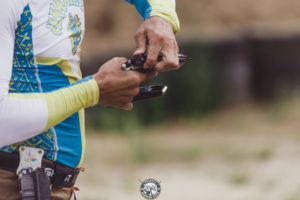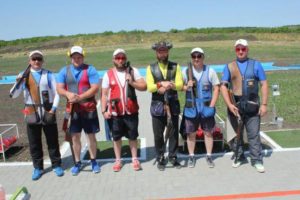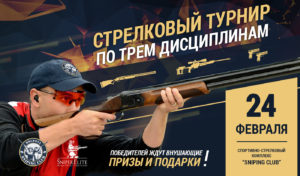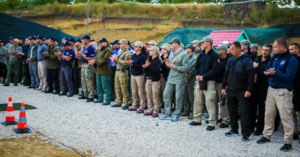
Articles
Lev Weinstein – “Psychotechnical training of the shooter”
Psychotechnical training of the shooter
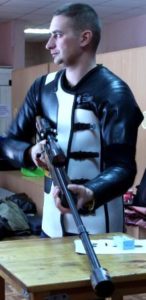
In competitions of arrows performs the same operations, as at a training. Difference of competitive firing in emergence a stress factors, influencing psychological state of the athlete.
Psychological state of the shooter and results of its firing are in close connection and interdependence. During conducting competitive firing the athlete consciously or involuntarily evaluates its results, compares them with usual or desirable level, predicts the end result of a performance, the possible place among participants of competitions. Under the influence of these estimates, its psychological state can change, mobilizing for the best work or causing its disorganization. One of important problems of training of the high-class shooter also is acquisition of ability to regulate the psychological state, providing readiness for conducting firing in different situations of competitive fight.
Stress factors of shooting sport are shows, with a bigger or smaller force, in all competitions. However, adaptation to them is complicated owing to emotional character of the phenomenon. The athlete perceives each competition somewhat again. At repetition or just complexity of a situation, the endured earlier emotional excitation is resumes fully or even amplifies.
The emotional reactions caused by participation in competitions gain properties of the stressor (exerting a negative impact on efficiency of the shooter) not in itself, and depending on the relation to them of the athlete, his predisposition to perceive their influence. There is an aphorism: “Would be angry, and the irritant will be!”. It fully belongs to the considered problem. PTT directed to “blocking” mentality of the athlete from perception of stressogenny influences of shooting competitions, or at least to weaken their influence.
Below the stressogenny, situations which are most often found in our sport and mental sets which can be used when carrying out PTT are considered. Keeping of the last can and should be adjusted taking into account individual requirements.
Situations of shooting competitions
Influence of a stress is closely connected with personal features of the shooter, value of these competitions for it and character of the arising situations. The same phenomena can get for one shooters the value of stressor for others is not present. In one conditions it is a stressor, in others is not present.
Example:
- Control selection firing by results of which the team’s line-up for a performance in the international competitions will be defined is carried out.
Arrows “A” knows that it has a firm situation. The good results shown them in last responsible competitions give the grounds to it. The result control will not exert any impact on its “rating”.
Arrows “B” understands that is a doubtful candidate. Only the good result of control firing if it is able to show it, will allow to expect the place in team.
- Line of fire of high-prestigious personal and command competitions. Arrows “A” understands that remaining with it three – four shots completing exercise will solve, it will become the winner or not. Arrows “B” before the completing shots has content, it was involved in work, results turn out at the good usual training level. It does not bring team, the fact that expected from it does, and he does not expect bigger, he is not ready to struggle with leaders yet. He will carry out the shots remaining with it with full attentiveness and self-confidence.
It is easy to understand that psychological state of shooters in the considered cases significantly differs. They perceive externally identical situation differently.
Psychological background
Each last competitions leave the print in emotional memory of the athlete, making the impact on forming of its psychological state in the subsequent competitions.
Let’s consider three cases:
- A successful performance in high-prestigious competitions. The continuing experiences of a celebration of a victory, a pride sense in connection with assignment of high sports titles, serious material encouragement. All this lays down a heavy burden on mentality of the athlete coming to a firing line of the next competitions, from it wait for result not worse. Behind its workplace the audience has crowded. Photolenses of numerous reporters are aimed at it.
The statistics shows very few people manage to repeat the success in competitions of the highest rank. The load of prestige complicates work. “Oh, you are heavy, Monomakh’s cap!”.
- Unsuccessful performance. The excessive self-confidence in work resulting in haste and negligence. Low results of firing of the first series have caused opposite tendencies: reinsurance in work on a shot, excessive care, and uncertainty in the actions. There were separations, not combination. All this causes feeling of disappointment, aspiration to a revenge, desire to be rehabilitated, prove the opportunities in the shooter. It will come to a firing line of the next competitions is able “combat readiness” and will show result at the level of the training achievements.
- The unsuccessful performance connected with a condition of a stress. Confusion, impossibility to focus on the actions, fussiness or block of movements. A state and work on a shot at all not those that were in a training. Results of a performance exclusively weak. The shooter leaves competitions to feeling of depression, negative attitude to competitive firing, situation of competitions. It is already almost psychological injury. A problem of PTT to force out the experienced serious conditions from memory of the shooter, to strengthen interest in sports activities, self-confidence, desire to try force in the next competitions to their stressogenny influence.
Starting state
The condition of the increased emotional strength arising on start is peculiar to all athletes of all sports. In shooting sport young arrows which mentality is not adapted to a situation of competitions, a celebration of opening, and understanding of the participation in them, the expected result of a performance yet are subject to the strongest influence. All this can seriously affect efficiency of the athlete, especially at the beginning of exercise performance.
For this category of shooters, the task not display in competitions of some good result, and development of performance of exercise in regulations of competitions should be set. Learning of ways of management of the psychological state. Not the result, but accumulation of experience of maintaining self-control in the conditions of competitions is important. Reduction of in a ready status to conducting firing. Conscious representation of this state and ways of its forming. This, the last, inner world of the shooter, only he can get into it.
Trial shots
Trial shots in itself do not contain stressogenny influences, but their insufficiently competent carrying out quite often creates stressogenny situations.
Practice shows that weapon of constantly training athlete does not demand entering of essential corrections into installation of a sight even during the changing of a shooting range and change of lighting. Nevertheless, many shooters consider trial shots (the provided rules of competitions) only as a validity check of fight of weapon.
Usually performance of exercise in competitions begins with trial shots. At the same time the shooter is under the influence of the starting state which is shown with a bigger or smaller force. At high extent of emotional excitation it is not necessary to begin firing at all. Only after reduction of in a ready status it is possible to get to work. At the same time some condition of emotional lift is tested the vast majority of shooters. It is shown in feeling of mobilization, sharpening of attention, the increased diligence in work on a shot. At the same time the athlete has no sense of responsibility for result of hit of trial shots. The shots made in these conditions quite often give good hits in a target. Making a shot behind a shot, seeing good results the athlete passes to a test target. But good trial have already caused a thought of good result, success of a performance. Aiming to keep the work, the shooter begins to control consciously the content of the actions which took place earlier is automated. Also psychological state changes. Fear of a bad shot causes excessive care in work, constraint of actions, reinsurance and the related tightening of a shot. Fear of this tightening and premature neobosnovatelny failure from its performance. Firing goes wrong, results of the first series often are weak. Not accidentally shooters say: “good trial – bad test!”.
Approximately following scheme of carrying out trial shots is submitted reasonable:
– Understanding that trial shots serve not only to a validity check of installation of aim adaptation, but also are training involving the shooter in serviceable condition.
– Make the first two-four shots in the normal training mode with the purpose to check combination of STP with the center of a target.
– Two – three shots with “overexposure” of a hand. Transition to the final phase of a shot to three – four seconds later than usual. It will serve as installation on prevention of spontaneous recession of a muscular tone after a usual operating time.
– One-two shots with focusing of sight on a tselika and concentration of attention on immovability of a front sight in a cut, fixing of a carpal joint.
– Two-three shots with concentration of attention on the final phase of work on a shot. Keeping of the scheme of switching of attention: aiming specification – effort of a forefinger – immovability of a front sight in a cut of a tselik – the Shot! – a mark, assessment of actions, installation on improvement – survey of a target in a pipe.
Two shots: one with increase in a gleam when aiming, another – just barely enough apple. It I will imprint admissible borders of the area aiming in visual memory.
Two – three shots in the normal “warm-up” mode. The last shot in a pipe not to examine. Trial are finished.
The stated above scheme can be adjusted, proceeding from readiness of the shooter for conducting test firing.
Nikafobiya
“Nickname” – the goddess of victory in Ancient Greek mythology. Nikafobiya – fear of a victory, the phenomenon which is widely observed in life when approach, the reality of approach, hotly desirable event causes the condition of euphoria which is extremely complicating performance of the completing actions.
In shooting sport the nikafobiya is shown in the reactions of a stress arising in competitions at the thought of display of good result, proximity (yet not won) a victory. It exerts the most disorganizing impact on efficiency of the shooter, complicating performance of the remaining shots.
Nikafobiya can exert the negative impact at the beginning of exercise, at results of the first shots or series, unusually high for the shooter. During firing when in a row there are shots (or series) with limit good result. At the end of successfully carried out exercise when it was necessary to make only a few not so difficult shots.
Numerous examples from practice of our sport give the grounds to say that the nikafobiya is the main stressofaktor of “big-time sports”.
The finals in firing
Final firing significantly differs from conditions of performance of the main exercise. The announcement of results of each carried-out shot, the arising visualization of a correlation of forces, put shooters in the conditions of direct single combat leaving the mark on psychological state of the athlete. The essential value at the same time has also position of the shooter in final group of participants.
Let’s review examples:
- The leading shooter, with a considerable separation from the following behind it, can quietly, fire without fear, being satisfied with results of usual level. It is enough for a successful completion of a series, available “backlog” does not give the grounds for concern.
At the same time this shooter can appear under the influence of a nikafobiya. The thought of the reached victory will cause psychological state, completely disorganizing work on the remaining shots. The most striking example told is the case with the Chinese athlete Van Ifu. Being in the lead with very big separation, it the seventh shot has got to “three” that caused in it an unconscious state. All advantage reached earlier has been lost by this shot.
- The leading shooter without essential separation from the following behind it. Lack of confidence of success. Fear that it can be got. Mobilization of all forces to leave from danger, to keep, reached by a hard work, advantage.
- Pursuing, lagging behind the leader on one – two points. He has feeling of disappointment for loss and at the same time considers what is not still lost, there is an opportunity to catch up with the leader. The concentration, determination, attentiveness and accuracy in work on each shot is necessary and it does it.
- Pursuing, lagging behind on three – four points. Probably, not to catch up with the leader any more, but chances to enter into the prize-winning three remain. There is nothing to lose. There is courageous, resolute, almost impudent work yielding quite often extremely good results. Sometimes, that it brings a victory.
Psychological barriers
Quite often the shooter aiming at assignment of a high sports rank does not manage to execute the standard granting on it the right in any way. In a training this level is mastered, however numerous attempts to show it in competitions terminate in failure, there are not enough two – three points.
The similar picture can be observed also in the highest echelons of sport. Before a record a large number of shooters who do not manage to overcome this boundary in any way crowds. Much manage to repeat, and lift a record in any way! However, when someone nevertheless manages to make it, behind it also all other athletes right there direct, crowding now before a new record.
The academician P.K. Anokhin explains the similar phenomena to existence in the central nervous system of “the mechanism of sentry point”. The reference point arising in subconsciousness of the shooter programs activity of an organism on achievement of a goal, but no more than that. The thought of approach of the desirable purpose, reality of its achievement, serves as a signal of completion of work, decrease in working processes. The record rises, there is a new reference point, also the program providing its achievement changes.
Volleyball players say that if the task not just is set to jump perhaps above, and to reach some subject, for example a tree branch, then the jump turns out higher.
Properties of “psychological barriers” can be used with success in our sport. The book by the American trainer Pullem contains the recommendation: if the shooter inspires in himself that it has already overcome some level of results, then it will significantly facilitate to it the real solution of this problem. Of course provided that potential opportunities of the athlete are sufficient for this purpose.
Psychological processes
Strengthening of the elements of “the second plan” which are dropping out of the field of attention of the shooter during the work on a shot and therefore quite often lagging behind in the development should become one of the PTT directions. Treat them:
– Feelings of size and constancy of effort of a grasp.
– Autonomy of work of a forefinger.
– The attention directed inside. Perception of immovability of standing, a tone of muscles, feelings of availability for service over a shot, feeling of reliability of stability of a hand with weapon and so forth.
– Level of requirements to the efforts, work “as will turn out”, or “as I demand”.
– Forming of installations and relations to different factors of shooting sport.
– Neutralization or “construction” of psychological barriers, depending on the developing preparation situation.
Shooter’s relations
The relations – predisposition to any activity, a situation, the personality. Form, as a rule, on the basis of beliefs, knowledge, but can have an emotional basis of feelings of sympathy or antipathy. The relations usually have constant focus and can exert impacts on behavior of the person.
PTT can be directed forming of the relation of the shooter to occupations by shooting sport, statement of the high sports purposes and strengthening of motivation of their achievement. To training process, developing thoughtfulness, criticality, internal discipline. On positive perception of competitive firing. To a successful or unsuccessful performance in competitions.
Let’s give the approximate maintenance of formulas of auto-suggestion which can be used when carrying out PTT:
– “I like the inspiring state arising at me in the firing line shooting competitions increasing interest in participation in them. Feeling of mobilization, courage and determination. I test readiness to fire with full attentiveness and confidence in the actions”.
After the successful performance, prevention of “star fever”.
– “I have followed a way to big-time sports. The purpose is achievable, but the way is difficult and far. Success in these competitions only “first signs” which do not do spring yet. Ahead long persistent and smart work and I am ready to it”.
After the unsuccessful performance. Prevention of negative impacts of a weak performance.
– “I shot badly, was ready better what has prevented? Where that weak link which has prevented me to make what I am able to do? I have feeling of disappointment, bitterness and rage on myself. In the next competitions I will not allow it. I know how the good result becomes and I am ready to show it in the next competitions”.
Psychological states
Readiness for conducting firing – difficult psychological state which forming takes place under the influence of a number of the factors having quite often opposite focus.
Let’s compare our sport to swimming. Psychological state of the swimmer does not change throughout a heat. After start at it one installation to work to the limit. In firing a little differently. The majority of exercises of the program of the World Cups and Olympic Games consists of a large number of shots, continues is long. This distance usually is not overcome “on one breath”. Results of separate shots and series can significantly differ. Behind a group of rounds, giving hits in the center of a target, separations and vice versa can follow. This irregularity of results of firing reflects dynamics of psychological state of the athlete. Its readiness or unavailability for conducting firing, performance of the actions mastered in a training.
Successful conducting competitive firing demands psychological state adequate to the situations developing during exercise performance. These situations (assessment by the athlete as it told above is more right than them) can change, causing the necessity of adjustment and psychological state of the athlete. It is possible to tell that there is a duel of consciousness of the shooter with the emotional reactions aiming to come out from under its control. The policy strokes used by the athlete in this fight consist in opposition to the arising stressogenny situations of the mental installations and images exerting alternative impact.
Psychologists of sport say that they equally promote achievement of a victory in competitions aspiration to a victory and the aspiration to avoid failure.
In major sports, three directions of self-attuning of the athlete on the site in competitions most often meet: on a victory, on decrease in the importance of competitions, on abstraction from a situation of competitions, “leaving in psychological blinders”.
In shooting sport all these three “the rights of nationality” have the forms, should “be adopted” by the athlete. Application of this or that of them in these conditions depends on many factors, are basic of which:
– Scale and personal importance of competitions.
– Last experience of a performance in competitions of a similar rank.
– Nature of exercise, external situation, and conditions of conducting firing.
– Personal features of the athlete.
– The tasks, which are put before the shooter in these competitions.
– Psychological background of a performance.
– The developing nature of firing.
– Psychological adaptation of the athlete to the required level of result.
As these states form
Let us imagine the actor studying a new role. He thinks over an image of the hero, identifies himself with it. Enters its state and behavior in various situations of development of scenic action. This mental work precedes the practical rehearsals held with participation of partners in the play.
Like it, the shooter should create “house preparations” of different options of psychological state. PTT will allow creating them, to keep in emotional memory of the athlete and to put into operation when it is demands by a situation.
In intense conditions of conducting competitive firing, it is difficult for the athlete and is once, to remember and think over necessary to it in this situation psychological state and to consider the factors influencing its forming. Here he thinks symbols, which have incorporated all these influences and are associated with the necessary state.
Other articles




